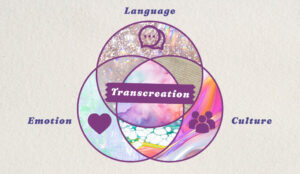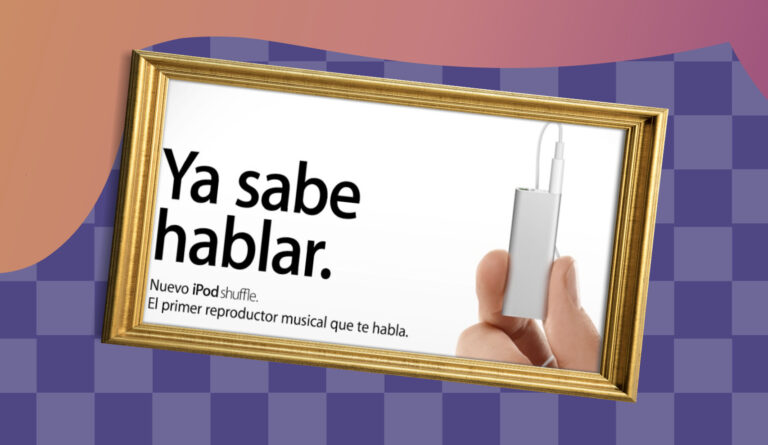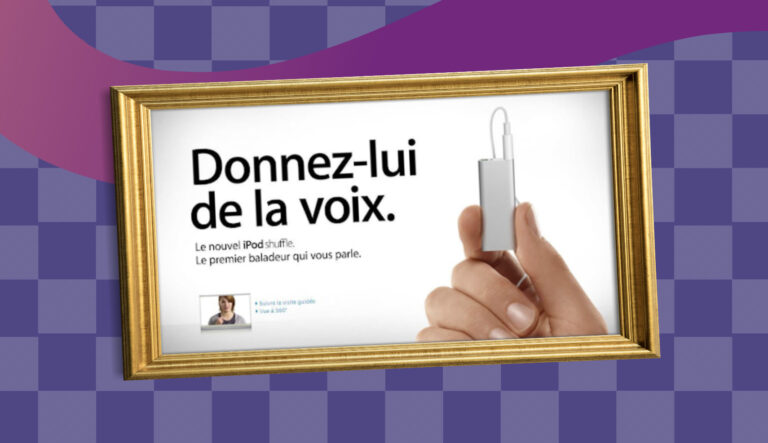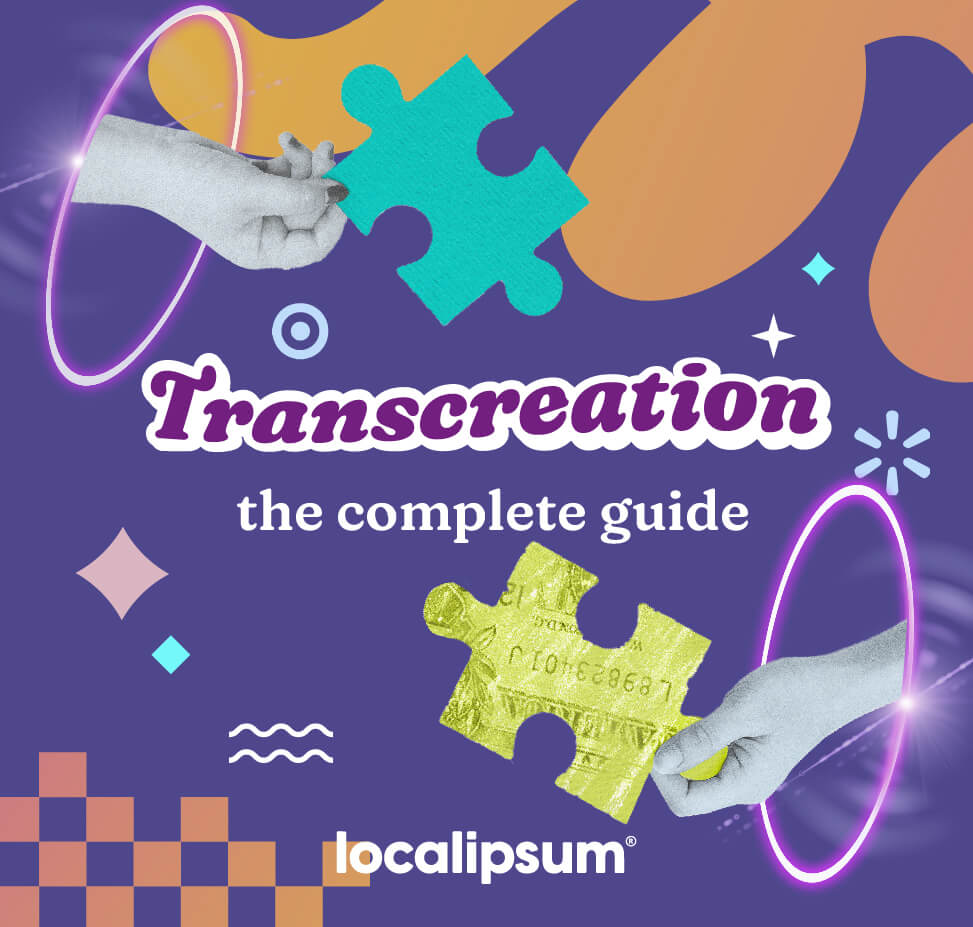Transcreation: A Comprehensive Guide for Global Brands
Global brands are in constant search of innovative strategies to broaden their horizons and connect with culturally diverse audiences. Many organizations, despite already having a global presence, struggle to find the right voice in their international expansion. Among the various strategies employed, Transcreation stands out as a formidable weapon in a marketer’s quiver. Let’s explore this world, from its definition to the crucial role it plays in bridging linguistic gaps.
Table of Contents
What is Transcreation?
For starters, what does Transcreation stand for? The term itself is a clever fusion of ‘translation’ and ‘creation.’ It’s a bit like blending the art of understanding with the finesse of artistic expression. When you break it down, ‘trans-‘ comes from the Latin ‘trans,’ meaning ‘across’ or ‘beyond,’ and ‘creation’ signifies the act of bringing something entirely new into existence. Yep, that’s for our language-lovin’ gen (once again).
In essence, Transcreation embodies the idea of taking a message from one world and crafting it anew in another. It’s a creative metamorphosis.
To truly appreciate the power of Transcreation, it’s essential to differentiate it from translation. For starters, Transcreation goes beyond the rigid, word-for-word approach. Instead, it truly breathes life and culture into the content. It ensures that the message remains authentic and compelling in the target language, ensuring the brand’s essence shines through in any language.

The History of Transcreation
The concept of Transcreation first appeared during the mid-20th century. In the 60s and 70s, language professionals from India and Brazil started offering this service in the industry of foreign entertainment, mainly in books and films. Fun fact: Transcreation is extremely popular in this field, and it’s typically the first encounter that non-translators have with it. We have a whole Instagram post about The Sound Of Music (or, should we say, “La Novicia Rebelde” or “Sonrisas y Lágrimas”?) and the importance of movie title transcreation.
Marketing and advertising agencies recognized this process as a fresh service they could introduce to meet the needs of an ever-expanding global market. They could present their Transcreation services as a valuable means to extend the scope of their clients’ offerings.
The concept of Transcreation is similar to assembling a message using pixels on a screen. Just as each pixel contributes to the overall image, Transcreation meticulously weaves together linguistic and cultural nuances to form a coherent message. In our hyper-connected world, Transcreation ensures that a brand’s voice remains impactful and culturally relevant through websites, e-commerce, digital marketing platforms, and social media channels, displayed in various corners of the world.
Benefits of Transcreation
Enhanced Customer Engagement
When you use Transcreation to craft content that speaks to the heart and mind of your target audience, you’re more likely to engage customers and build stronger connections. As we’ve mentioned, Transcreation isn’t just about translating words; it’s about evoking emotions and resonating at a deeper level.
At the very least, consider that most people won’t even consider making a purchase online if the website isn’t available in their native language: just imagine introducing a service or a product in a foreign market, solely in English, with minimal to no changes at all compared to how it’s portrayed in the United States.
Boosted Sales and Profits
Effective Transcreation can have a direct impact on your bottom line. By ensuring that your message is persuasive and crystal clear – culturally speaking – you increase your chances of turning potential customers into paying ones. This leads to higher sales and, ultimately, greater profits.
Accurate Brand Image
Consistency is king – and key – when building a strong brand, and Transcreation certainly plays a pivotal role in the job. Let’s talk about a real case: Nike’s “Just Do It” metamorphosis while expanding the brand into Chinese markets.
Nike has been present in China since the 80s, however, the company’s business and communication strategy was far from perfect. This slogan that sits comfortably in the hall of fame of advertisers and marketers was a part of the problem too. It’s virtually impossible to translate without losing its original and intended meaning. But leaving the brand insignia behind was never an option. A wall was hit, and it was time to make some decisions. Transcreative decisions.
The Nike team decided to use the slogan, combined with transcreated taglines in Chinese that fit each marketing campaign seamlessly. With these additions, “Just Do It” gained a place among the public.
The company’s iconic “Just Do It” slogan encompasses so much meaning that it is practically impossible to translate. Yes, the company could have translated the slogan but, then, it would have lost the iconic message that helped make it a global hit in the first place. Take a look at Nike’s The Next Wave, the Post-Olympic Ad campaign.
Culturally Appropriate Messaging
Transcreation ensures that your messaging is not just linguistically accurate but also culturally appropriate. What works in one culture might not have the same effect in another, and seemingly minor cultural missteps can have a significant impact on your brand’s reputation and credibility.
Each culture has its own set of idiomatic expressions, sayings, and metaphors. Transcreation involves identifying and adapting these expressions in a manner that makes sense. Humor also varies widely from one culture to another, and references that are amusing in one region may not be understood or extremely inappropriate in another.
Transcreation vs. Translation:
What is the difference?
Translation and Transcreation… two processes that we certainly know and love. Although related, they serve distinct purposes in the world of language and communication. Understanding the differences between the two is essential in determining which approach to employ for your content strategy needs.
In the world of translation, the primary objective is to render content accurately from one language to another while preserving the original meaning. Translators aim for a word-for-word or phrase-for-phrase conversion, maintaining precision and consistency with the source text. On the other hand, Transcreation moves beyond the literal translation of words. It prioritizes the emotional and cultural impact of the content in the target language, often requiring a deep understanding of the target public’s cosmovision. The emphasis in Transcreation is on conveying the core message rather than adhering strictly to the source wording.
Translators are language experts who specialize in linguistic accuracy, possessing a deep – and sometimes freaky – understanding of grammar, vocabulary, and sentence structure in both source and target languages. In contrast, Transcreation specialists combine linguistic proficiency with creative talents. They are not only fluent in multiple languages but also skilled in copywriting and editing. They may or may not hone their skills by rewatching Mad Men. Again. And again. And again.
The choice between Transcreation and translation often hinges on the type of content at hand. Translation is typically the preferred approach for materials where precision and adherence to the source text are paramount. This includes legal documents, scientific publications, technical manuals, and literary works where maintaining the author’s original words is crucial. Transcreation, on the other hand, is most valuable for marketing materials, advertising and political campaigns, brand messaging, and creative content.
In terms of cost, translation is generally the more cost-effective option: it involves a straightforward conversion of words. Transcreation, in contrast, can be more costly. It requires the creation of new messaging, often involving the expertise of other professionals and Transcreation specialists. This creative effort and time investment can result in higher costs, but the investment is often justified by the results when engaging and emotionally resonant content is essential.
Both activities follow distinct processes. Translation starts with the source text and translators working directly from the original content. There is no need for a creative brief as the source material provides the necessary guidance and context. Transcreation, however, begins with a creative brief. This brief outlines the core message, objectives, and the desired emotional impact on the target audience. Transcreators use this information to create entirely new messaging that aligns with these objectives.
Perhaps the most significant difference is that translation recreates the original message. Instead, Transcreation could result in entirely new messaging.
The Transcreation Process Step-by-Step
1. Client Briefing: This is a crucial step where the client provides detailed information about the project, including the target audience, goals, messaging, and cultural nuances that need to be addressed. The Transcreation team needs to gain a deep understanding of the client’s expectations and the context in which the content will be used.
2. Market and Audience Research: Following the briefing, Transcreation experts conduct thorough research on the target market and audience. This involves applying their knowledge of the local culture, values, and preferences to ensure that the transcreated content remains accurate – and relevant.
3. Creative Brainstorming: With a solid understanding of the client’s objectives and the target market, the transcreation team engages in an arduous session of creative brainstorming. There’s even an imperial Japanese symbol that represents this process: 
4. Content Adaptation: We’ve reached the heart of the Transcreation process. This step involves crafting new messaging that captures the emotional and cultural nuances of the target audience. It’s about creating a message that transcends like Disney’s Buzz Lightyear: to infinity and beyond.
5. Quality Assurance: Quality assurance is as much a critical component of the Transcreation process as it is for translation. The content undergoes rigorous editing and proofreading to ensure linguistic accuracy, cultural relevance, and alignment with the client’s objectives. This step may involve multiple revisions to fine-tune the content and meet the highest standards of quality.
6. Client Review and Feedback: Once the Transcreation team is satisfied with the content, it is presented to the client for review and feedback. This stage allows the client to ensure that the content aligns with their vision and objectives. It may involve revisions based on the client’s input to achieve the desired result.
7. Testing and Implementation: Before the content is deployed, it may undergo testing to ensure that it works effectively in the intended context. This could include website testing, advertising campaigns, or other marketing efforts. Depending on the usage and extensive outreach the transcreated content will have – along with the funding allocated to the campaign – it may undergo multiple rounds of focus group insights in the target language/community.
8. Ongoing Evaluation: The Transcreation process doesn’t end with the content’s implementation. Professional translation agencies often engage in ongoing evaluation to assess the content’s performance. This involves analyzing its impact, garnering continuous feedback, and making adjustments to the SEO campaigns to continuously improve the effectiveness and outreach of the content.
Professional translation agencies (ever heard of Localipsum?) manage Transcreation projects by following these steps to ensure amazing results. Since you’re already here, you may want to check out how the Localipsum magic happens.
Transcreation: Examples for the Books
Okay, we’ve covered the principles of the Transcreation process quite a bit. Now it’s time to bring up some real-world examples of transcreated marketing campaigns in which goals were – or were not – successfully achieved. Let’s start with the bad ones, because well… they’re quite funny.
If you’ve been following us on Social Media for a while (and if you haven’t, shame on you! Follow us on our Instagram & LinkedIn), you know there’s one specific example of bad Transcreation we love to quote. Oh, yeah!!! It’s time to talk about KFC’s failed slogan in Chinese. “Finger-Lickin’ Good” evolved into its Hannibal Lecter era once KFC opened its first location in China. Why is that? Because its transcreated version resulted in an invitation to the population to “Eat their fingers off”.
And now, on to Mitsubishi Motor’s X-Rated Failure: the renowned automobile manufacturer, once made an X-Rated Transcreation blunder during the launch of its hot SUV model in Spain: the Mitsubishi Pajero. It seems the creative brains at MM decided to skip this critical step of brand analysis when transadapting their global reach. Dear reader, there’s no PG-Rated way to say this… the word “Pajero” in some Spanish-speaking countries translates to “tosser” or “wanker” – a different invitation to their target population compared to KFC’s. Unsurprisingly, this linguistic oversight posed a substantial challenge to the car maker’s reputation and sales prospects. Realizing the gravity of this linguistic misstep, Mitsubishi Motors promptly took corrective action. They made the wise decision to transcreate the name for the Spanish audience, rebranding it as “Monteiro.”

Laughs aside, let’s check some transcreative campaigns that certainly changed the game.
Are you in the mood for some Gummy Bears? Haribo, the beloved German confectionery, demonstrates a masterful execution of Transcreation through its iconic slogan, “Haribo macht Kinder froh, und Erwachsene ebenso”. This delightful German catchphrase effortlessly translates to “Haribo makes children happy, and adults too” in English, resonating universally. However, the magic of Transcreation truly shines through when Haribo adapted this message into various languages, including Dutch, and French to evoke joy and sweetness universally.
- Dutch: “Luk op for noget godt! Luk op for Haribo! Den er go” (Open for something good! Open for Haribo! It is good)
- French: “Haribo c’est beau la vie, pour les grands et les petits” (Haribo life is beautiful, for big ones and little ones alike)
Do you remember the iPod shuffle? Well, Apple impulsed a seemingly straightforward yet impactful slogan “Small Tech”. While this catchphrase effectively highlighted the device’s compact nature and efficiency, the direct translation often lost its intended meaning, prompting Apple to embark on a Transcreation journey.
- French: “Donnez-lui de la voix” (Let him speak)
- Canadian French (Québécois): “Petit parleur, grand faiseur” (Says little, does much)
- Latin American Spanish: “Mira quién habla” (Look who’s talking)
- European Spanish: “Ya sabe hablar” (It already knows how to speak)



We’d love to let you in on a little secret… There’s nothing more thrilling to our Chief Troublemaker (aka ideator) than engaging her brain in a transcreation campaign. Here’s an example of our team’s endeavors with a fabulous client. We embarked on a pioneering Transcreation project with our client, Ship It Zero, culminating in the creation of the video campaign, “Shady Ships.” This campaign, strategically designed to uncover the concealed environmental and public health repercussions stemming from retail companies’ heavy dependence on fossil-fueled maritime shipping, represents a testament to the power of Transcreation in sparking critical conversations. See all Project details here.
Navigating Transcreation with Confidence
At Localipsum, our approach is defined by more than just crafting words – it’s about putting people first and building cultural harmony. We’re committed to delivering language services that transcend words, including Transcreation: we even have a entire page dedicated to describing our transcreative services to perfection.
Our pledge is to stand alongside our clients, understanding their unique needs, and collaboratively shaping narratives. For us, Transcreation isn’t merely a service; it’s a conduit for fostering meaningful connections and amplifying the human essence in every message. Let’s build something exceptional together.

